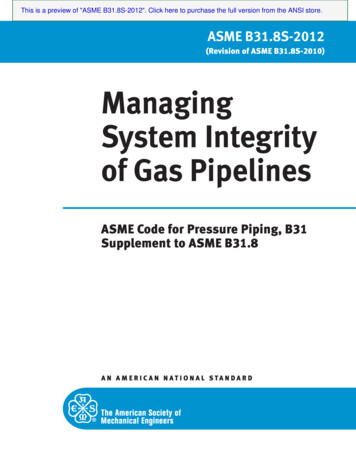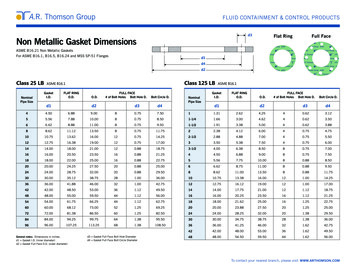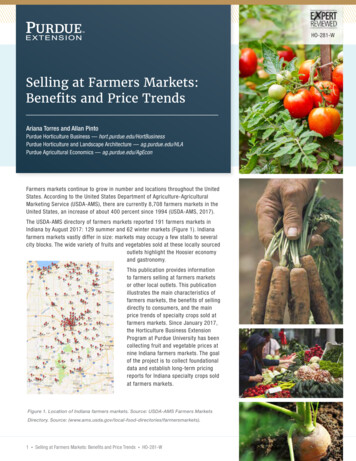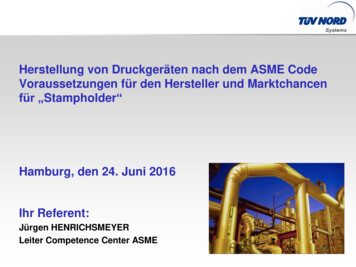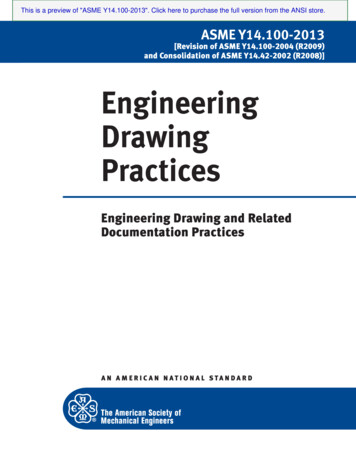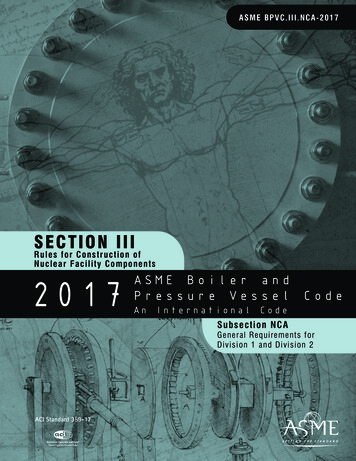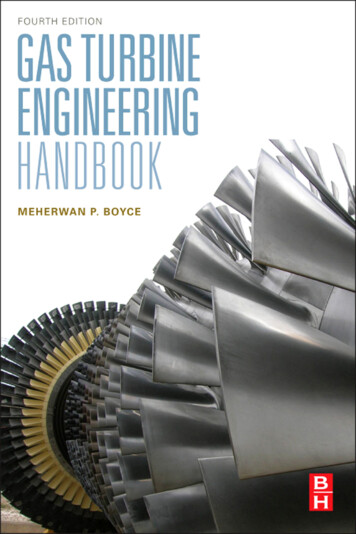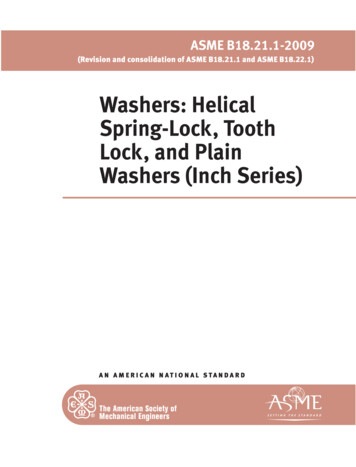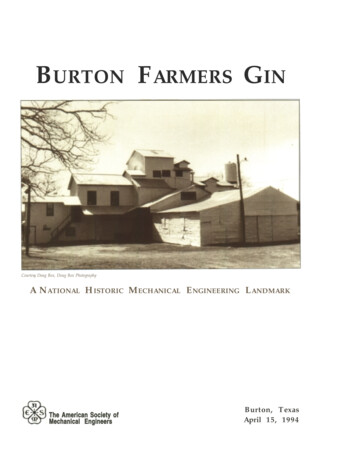
Transcription
BURTON FARMERS GINCourtesy Doug Box, Doug Box PhotographyA N ATIONAL H ISTORIC M ECHANICAL E NGINEERING L ANDMARKThe American Society ofMechanical EngineersBurton, TexasApril 15, 1994
Photograph of the Burton Farmers Gin as originally constructed. Notice the steam boiler smoke stack rising above a simple roof line. In 1925, a seedhouse was added to the front of the gin and the roof line altered to house seed elevators and stick removal equipment. An engine room with a business office above it was added to the left side of the building to house the Bessemer Type IV oil engine.Th e significance of the Burton Farmers Gin iswoven into the fabric of the industrial revolution. The extreme difficulty of ginningcotton, that is separating the fiber from the seeds,was a problem which had plagued mankind forfour thousand years. Past civilizations from aroundthe world had tediously hand separated the cottonseeds from the lint until the invention of the circular saw teeth gin design which was developed inthe United States between 1789 and 1805. This“Cotton Engine” combined with the introduction ofthe first large textile mills in New England to startan inevitable chain of events that would fuel theindustrial revolution.The development of the American cotton ginning industry began with plantation-owned ginswhich were turned by hand or farm animals. Thecommunity gin, which served smaller, independentgrowers, was a result of the Civil War and thedemise of the plantation. Steam engines were introduced to power the individual machines, like thegin stand and press, but manual labor was stillrequired to move the cotton from one operation tothe next. The development of the system cottonginning plant by Robert Munger introduced the ideaof pneumatically conveying the cotton from thewagon to the press while mechanical conveyorshandled the seed and trash from the ginned cotton.The Burton Farmers Gin represents the turn-ofthe-century revolution of cotton ginning from alabor intensive operation to the system gin whichwas powered by a single engine. The economicimportance of the community cotton gin was notjust to provide cash to the local grower. River andrail transportation systems profited, ocean portswere developed, and cotton textile mills in NewEngland and Europe were supplied. The industrialrevolution flourished.1
ROBERT S. MUNGER was born in July, 1854, in FayetteCounty, Texas. Between 1883 and 1892, Munger would devise theconcept and technology of system ginning which is preserved in theBurton Farmers Gin and is still used by modern gins. Munger’s fatherbuilt a cotton gin in Mexia, Texas, and Robert S. Munger was raisedin the family gin.Robert S. Munger, inventor of system ginning.Courtesy Continental Eagle CorporationSuction pipe unloading seed cotton from a wagon.Courtesy Doug Box, Doug Box PhotographyFrustrated by the long line of wagons, impatient farmers, and aninability to fill available rail cars, Robert Munger completelyredesigned the hundred-year-old tradition of the plantation style ofginning. His concept was to use fans to create a pneumatic systemfor conveying the seed cotton to the gin stand and the subsequentcotton lint from the gin stand to the bale press. Seed cotton wasdrawn out of wagons by ‘telescope’ suction pipes. The seed cottonwas conveyed by air stream to a separator, mounted above the ginstands. A suction fan pulled seed cotton into the separator where theair would pass through a screen and the cotton would fall into a distributor above a group, or battery, of gin stands. The cotton was thendistributed by means of the moving belt to feeders above each stand.The battery of gin stands was typically comprised of four or five unitswhich could be operated together or separately. A common lint fluebehind the gin stands provided a continuous flow of ginned cotton.The lint was then blown through this common flue to a single largecondenser that replaced the small unit condensers formerly attachedto each gin stand. The condenser contained a screen drum which separated the cotton lint from the air flow. Dust and fine particles wereblown out through chimney stacks that passed through the roof. Tohandle the increased amount of cotton coming from the condenser,Munger invented the double-box press. Each box, attached to awooden center post, was sized to contain one bale. The lint nowflowed along a slanting chute or slide from the condenser to the pressbox. As one box was being filled with lint, the other was pressed,wrapped, tied, and rolled out onto the floor to be weighed, makingbaling as continuous as ginning.Robert Munger’s radical new system was so successful that hebuilt a manufacturing plant in Dallas. The Munger Improved CottonMachine Manufacturing Company was incorporated in 1887.Munger traveled to Birmingham and formed a partnership with W T.Northington and Daniel Pratt to create the Munger-Northington-PrattCompany to market ginning systems east of the Mississippi River.Supported by the foundation of the Daniel Pratt Gin Company, thisnew alliance would form the framework of the Continental GinCompany. Today, the Continental Eagle Corporation continues thelegacy of the inventor and entrepreneur, Robert Munger.Belt driven fan for Munger’s pneumatic system of cottonginning.Courtesy Richard Hofmeister, Smithsonian Institution2
FRANKLIN H. LUMMUS was born in 1824 in Massachusetts.Lummus and his father formed the New York Car and Steamboat GasCompany in 1857. After service in the Union Army, Lummus formedthe New York Cotton Gin Company with partners Joseph Wilde andHenry C. Hogden. (Note that Mr. Hogden was descended from H.Ogden Holmes who had received caveats of invention for the cottongin from the War Office in 1789.) In 1867, Franklin H. Lummusbought Israel Brown’s share of a competing cotton gin manufacturer,W G. Clemens, Brown, and Company. In 1879,first one son, E. FrankLummus, and in 1887, another son, Louis E. Lummus joined the company. F. H. Lummus Sons Company was formed in 1891. In April,1896 four months after the death of Franklin H. Lummus, the familyowned company became a corporation.Franklin H. Lummus. From F.H. Lummus Sons Co.Catalogue, 1909; courtesy Lummus CorporationThe F. H. Lummus Sons Company continued to grow, creating aboard of directors, and acquiring land in Columbus, Georgia foradditional facilities. In 1899, the company moved from Juniper,Georgia to Columbus, where a new manufacturing plant and oficewere built. By the turn of the century, Lummus was producing aboutsix hundred gin stands per year. Lummus manufactured five types ofgin stands, an elevator distributor, flues, a battery condenser, bothsimple screw and double box presses with steam trampers, and screwconveyors for seed handling.Lummus gin stand. Seed cottonis distributed by overheadconveyer and dropped into thefeeder.Courtesy Rihard Hofmeister,Smithsonian InstitutionLummus was a pioneer in ginning research and was particularly attracted to the air blast method for doffing lint from the gin saws.In 1908 Lummus commissioned the Epps Air Blst Gin Company ofSherman, Texas, to manufacture and sell air blast doffing attacbments. In 1910, Lummus opened a branch office inDallas and changed its name to Lummus Cotton GinCompany. As the air blast principal became accepted byginners, Lummus issued licenses to Continental and tothe Stephen D. Murray Company of Dallas to manufacture air blast attachments for their gin stands in 1916Today, Lummus Corporation continues as a successfulbusiness which has stood the test of time.3
Line shaft located on ground floor below the gin stands.Courtesy Richard Hofmeister, Smithsonian InstitutionDouble box bale press allowed cotton to fill the box onthe right while pressing and unloading a bale of cottonfrom the other box.Courtesy Ricbard Hofmeister, Smithsonian InstitutionGround floor view of the double box press which rotateson a center bearing post with hydraulic press block andcylinder under the box on the left.Courtesy Richard Hofmeister, Smithsonian Institution4THE BURTON FARMERS GIN is the oldest survivingexample of the rural community system type cotton ginwhich used Robert Munger’s concept of multiple standsand an integrated system of processing cotton from thewagon to a completed bale. It represents a mechanicalage before the industrial use of electrical power and is theoldest extant example of the once widely used system ginwhich was mechanically powered by a single engine.This gin also incorporated a technological developmentresulting from the December 5, 1893 patent of the multijet, air-blast gin by Robert King. The Lummus Cotton GinCompany designed the Burton Farmers Gin. Built in1914, it combined the skills of engineers, mechanics andcarpenters to bring the machine design, plant layout, andwooden structure into industrial harmony.The Burton Farmers Gin represents a significant modification in cotton-ginning technology adapted by theLummus Cotton Gin Company from the work of RobertKing and Robert Munger. Franklin H. Lummus had organized the Franklin H. Lummus Company in 1867 for themanufacturing of cotton gins. In 1910, Lummus opened abranch office in Dallas, Texas, and changed the companyname to Lummus Cotton Gin Company that year.Lummus was particularly attracted to the air-blast principle for doffing lint from the gin saws. Lummus’ engineersapplied Robert Munger’s concept of pneumatic conveyingof cotton and the system gin.This design used air to bring seed cotton from thewagon to a separator inside the building. The separatorserved to clean the cotton and separate the cotton fromthe air flow. Cotton dropped from the separator into asealed, belt-distribution system that carried the cotton tofeeders above a row of gin stands. Several gin standswere linked by flues to convey the ginned lint into a battery condenser above the bale press. Seed disposal wasalso automated, incorporating a system of wooden conduits, screw conveyors, and bucket elevators. Mungerincreased baling capacity by using a double box press,placed on a turntable to allow feeding and tramping ofone box while hydraulically pressing and unloading theother box.
In the Burton Gin, the entire ginning system ismechanically driven by a single power source. TheBessemer diesel engine powers the ginning equipmentthrough a line shaft, pulleys, and flat belting. This was acommon arrangement for gins built during the first half ofthe twentieth century, but very few survived past 1970.The Burton Farmers Gin also represents elements ofthe evolution of industry from steam power, to the dieselengine, and finally to electrical power in the last decadeof the gin’s commercial life. The original 1913 design wasdriven by a typical cotton gin boiler and steam engine.Cord wood for fueling the boiler was readily available astimber was cleared to make farm land. Little is left of theoriginal steam engine except for the whistle above theengine room; the riveted steam accumulator vessels,which were converted for diesel exhaust mufflers; and theconcrete-pillar supports for the steam engine. These concrete pillars now support timber bracing for the l25horsepower, Allis-Chambers, 480 volt, 3-phase electricmotor installed on the gin floor in 1963. The steamengine was replaced by a Bessemer Type IV, twin cylinder, oil engine in 1925. Machinery developed in the1920’s made the price of hand-picked cotton, with a minimum of trash, higher than the charge for mechanicallypicked cotton with mechanical trash removal at the gin.The Burton Farmers Gin added the equipment needed toremove the trash from the seed cotton.However, the steam boiler and engine were not powerful enough to turn the added equipment. The Bessemerdiesel engine was installed in 1925 and powered the ginuntil the outboard crosshead failed during the 1963 ginning season. Cotton wagons quickly filled the town whilethe engine was hastily repaired. Beaumier Iron Works innearby Brenham, Texas, provided a replacementcrosshead. The Bessemer was repaired, and returned toservice, but members of the Farmers Coop felt that it wasno longer reliable as a power source. The Allis-Chamberselectric motor was purchased and the Bessemer became astandby power source. The 1974 cotton crop marked thelast year of commercial operation for the Burton FarmersGin with a total of seven bales ginned by equipment capable of ginning seven bales per hour. Cattle had replacedKing Cotton.The Burton Farmers Gin is complete with not only the ginmachinery, but also the paper records, dating from incorporation in 1913. These records chronicle the history ofthe gin as equipment was added. They also preserve ahistory of cotton production and sales in WashingtonCounty, Texas, over a period of sixty years.Courtesy Richard Hofmeister, Smithsonian InstitutionCourtesy Richard Hofmeister, Smithsonian Institution5
T6Both the horizontal cleaner andstick machine are 50 inches (1.27 m)wide. Cotton passes out of the burrmachine and into the conveyor-distributor above the gin stands. Thereare five gin stands, each equippedwith 80 saws for separation of thelint from the seeds. The ginned seedsare transported to an outside hopperby a conveyor under the gin stands,a bucket elevator into the seedscales, and a second screw conveyor.The ginned lint is doffed from thesaws by an air blast fan which alsoconveys the lint to the lint cleaner.he engine powers the ginthrough a main line shaft, 57feet (17.37 m) in length and 215/16 inches (6.55 cm) in diameter.There are a total of 19 flat belt driveson the main line shaft and over 20drives on secondary jack shafts.These drives use over 600 feet(182.88 m) of belting ranging fromtwo to eight inches (5.08 to 20.32cm) in width. A 40-inch (1.02 m)diameter suction unloading fanmoves the cotton from the trailer tothe 50-inch (1.27 m) diameter separator above the distributor. Cottonmoves through a tower drier andThermo Cleaner and into a horizontal cleaner located on the third floorof the gin. The tower drier andThermo Cleaner can be bypassed ifthey are not needed. Cotton passesthrough the horizontal cleaner, into atwo-saw stick machine and into aneight-foot (2.44 m) wide burrmachine.7The cotton gin is powered by ahorizontal two cylinder 14” (35.56cm) bore x 18” (45.72 cm) strokeBessemer Type IV Oil Engine ratedfor 125 hp (92.5 kW) at 250 rpm.The shipping weight of the enginewith clutch and standard equipmentis 31,738 pounds (14,426.4 kg). Theoil engine is of the two stroke dieseldesign with water injection providedto each of the respective intakeports. The oil engine is designed tofire various fuel oil grades withadjustable water injection to provideproper combustion. The 323 lb.(146.8 kg) pistons stroke at 180degree intervals. Each piston drivesa horizontal rod which threads into asliding crosshead assembly containing a wrist pin for the connecting rodto the crankshaft which drives two78” (1.98 m) diameter 3,285 lb.(1493.2 kg) flywheels. A flywheelgovernor acts to center the eccentricdrive to the fuel injection pumpplunger which speed regulates theengine at 250 rpm. A shoe typeclutch with manual lever engagement is fitted to the drive shaft on theother flywheel.In order to facilitate operationsand restore the gin to 1930’s configuration, the horizontal cleaners, stickmachine and burr machine havebeen bypassed. As previously noted,the Moss lint cleaner, installed in1954 has also been bypassed.Another fan conveys the lint from thelint cleaner to the condenser abovethe press. The press is a Lummus flatbale press with wooden doors andsteel sills and side beams.
Burton Farmers Gin before restoration 1986.Photo by Rick Lewis, Texas Historical Commission.THE RESTORATION PROJECTThe Cotton Gin lay dormant from 1974 to 1986,when a group of local citizens formed an organization to save the property from being sold. The nonprofit organization incorporated under the nameOperation Restoration, Inc. and acquired the ginwith a loan from one of the members. After several years of research and planning, restoration beganin late 1990.The restoration has progressed in several phases. The initial phase involved a thorough cataloging of all resources. This included an extensivephotographic recording process by the SmithsonianInstitution. All gin records were indexed and storedin acid free boxes. During this time, OperationRestoration was formed and plans were made forthe museum and interpretive center.The next major restoration project was the8Bessemer engine. The project was basically anoverhaul of the engine and a rebuilding of the fuelinjection system. A 5,000 grant from CooperIndustries provided the funding for most of theexpenses for repairs to the engine. Parts, materials,and services were donated by many companies andmachine shops from throughout the state of Texas.The engine was started for the first time onFebruary 29, 1992, and has been operated forapproximately 100 hours since the overhaul.Once the engine was operating, the next phaseof restoration was to rehabilitate the gin machinery.The four fans were removed and repaired. All flatbelting was inspected and, with few exceptions,was replaced with “new” belting. The belting wasdonated from a number of sources that no longerhad use for it. The restored fans were re-installed.
The saws in the gin stands and feeders were inspectedand found to be in excellent shape. The hydraulic pumpfor the bale press was manufactured by Beaumier IronWorks in nearby Brenham, Texas. This company is stillin operation, although they no longer operate a foundryor build press pumps. The existing pump was extremelyworn and in need of extensive repairs. Beaumier IronWorks was generous enough to provide the parts to buildanother pump and the original pump is being used for astatic display. In order to restore the gin to its 1930’s condition, the Moss lint cleaner was by-passed and the cottonwas routed from the gin stands directly into the press.The gin stands needed several days of cleaning and oiling, but were otherwise in excellent condition.The final phase of restoration involved the buildingitself. Overall, the building was in good conditionalthough it did show the effect of 20 years without maintenance. The roof had a few leaks and some of the woodwas beginning to show signs of decay. In the spring of1993 the roof was repaired and decayed wood wasreplaced. After the roof was repaired, the entire buildingwas painted with an industrial coating. Additionally, a setof rear stairs were installed to facilitate tours movingthrough the building. The location and design of thesestairs and the painting of the building was coordinatedwith, and approved by, the Texas Historical Commission.The Burton Farmers Gin survives in its original building and it is operating with the machinery that was in thegin when it closed down. It is open for guided tours, andthe Bessemer diesel engine is in operation during the thirdweekend of April for the annual Burton Cotton GinFestival.The Bessemer Type IV oil engine is, by itself, an historic piece of equipment. It is the largest operating internal combustion engine of this vintage in the southernUnited States, and possibly, the entire country. There arecertainly few, if any, engines of this age and horsepowerin operation outside of a museum. Its restoration is astory of an old engine and interested young people. Theoldest of the people who helped to restore “The Lady B”,as it is called, were young people in 1925. “The Lady B”had been idle for twenty years when the overhaul workbegan in January of 1991.Battery of five Lumus 80-saw gin stands.Courtesy Richard Hofmeister, Smithsonian InstitutionBessemer engine drives the line shaft through a clutch onthe right with the clutch handle shown in the foreground.Courtesy Doug Box, Doug Box Photography125 hp Bessemer Type IV oil engine installed in 1925.Courtesy Doug Box, Doug Box Photography9
The heads and hot plug ends were off. The pistons werecorroded and seized to the pitted cylinder walls. The castiron cylinder cooling water jackets were cracked. Theforced feed oil lubricator and geared fuel pump weregone. The fuel injector pump and injectors were a corroded basket case. The cooling tower and water tankwere rotten and useless. The twin, eight-inch-diameter(20.32 cm) exhaust pipes had been dug up and cut intoroad culverts. One piston-to-connecting-rod crossheadwas broken. The fuel-oil, water and air-start piping hadbeen removed. The Model T engine for powering thestarting air compressor and the starting air receiver weregone. Also, the men with the memories of how this puzzle fit together had been lost to time.Bessemer engine nameplate.Courtesy Greg FelderCooper Energy Aftermarket Services, Mount Vernon,Ohio, provided an original printing of the engine parts list,and the original drawings of the parts had survived onmicrofilm. Many companies donated components andservices, such as the cooling water tank, a pressure vesselfor the air start system, repair of the engine crosshead, 200ft. (59.96 m) of 8-inch (20.32 cm) diameter exhaust pipe,and a ratchet-drive lubricating oil pump. A group of dedicated volunteers worked on Saturdays for fourteenmonths until the Bessemer diesel engine started onFebruary 29, 1992.Bales of cotton with a model of Eli Whitney’s handcranked “Cotton Engine.”Courtesy Doug Box, Doug Box Photography10
THE HISTORY AND HERITAGE PROGRAM OF ASMEThe ASME History and Heritage Recognition Program began inSeptember 1971. To implement and achieve its goals, ASMEformed a History and Heritage Committee, composed of mechanical engineers, historians of technology, and the Curator Emeritusof Mechanical and Civil Engineering at the Smithsonian Institution.The Committee provides a public service by examining, noting,recording, and acknowledging mechanical engineering achievements of particular significance. The History and HeritageCommittee is part of the ASME Council on Public Affairs andBoard on Public Information. For further information, please contact Public Information, the American Society of MechanicalEngineers, 345 East 47 Street, New York, NY 10017-2392, 212-7057740; telefax 212-705-7141.The Burton Farmers Gin is the 109th National HistoricMechanical Engineering Landmark to be designated. Since theASME History and Heritage Program began, 163 HistoricMechanical Engineering Landmarks, 6 Mechanical EngineeringHeritage Sites, and 6 Mechanical Engineering Heritage Collectionshave been recognized. Each reflects it influence on society, eitherin its immediate locale, nationwide, or throughout the world.An ASME landmark represents a progressive step in the evolution of mechanical engineering. Site designations note an eventor development of clear historical importance to mechanical engineers. Collections mark the contributions of a number of objectswith special significance to the historical development of mechanical engineering.The ASME Historic Mechanical Engineering RecognitionProgram illuminates our technological heritage and serves toencourage the preservation of the physical remains of historicallyimportant works. It provides an annotated roster for engineers,students, educators, historians, and travelers, and helps establishpersistent reminders of where we have been and where we aregoing along the divergent paths of discovery.11
THE AMERICAN SOCIETY OF MECHANICAL ENGINEERSJohn H. Fernandes, PresidentDale S. Baird, Vice President, Region XGeorge Butler, History & Heritage Chairman, Region XThomas D. Pestorius, Senior Vice President, Public AffairsErwin Fried, Vice President, Public InformationDavid L. Belden, Executive DirectorDavid Cook, Director, Southern Regional OfficeTHE ASME NATIONAL HISTORY & HERITAGE COMMITTEEEuan F. C. Somerscales, ChairmanRobert M. Vogel, SecretaryRobert B. GaitherR. Michael Hunt, P. E.J. Lawrence Lee, P. E.Joseph P. van Overveen, P. E.William J. Warren, P. E.Richard S. Hartneberg, P. E., EmeritusDiane Kaylor, Staff LiaisonTHE ASME CENTRAL TEXAS CHAPTERPaul Forderhase, ChairmanGary Sutoriuse, Vice ChairmanKerry Russel, TreasurerJerry Jackson, Past ChairmanRickey L. Bryan, History & Heritage ChairmanOPERATION RESTORATION, INC.Rickey L. Bryan, PresidentBob Whitener, Executive Vice PresidentWanda Whitener, Vice PresidentHenry C. Wehring, Vice PresidentGreg Felder, SecretaryRita Bryan, Treasurer12
BIBLIOGRAPHYBritton, Karen Gerhardt, Bale O’ Cotton, Texas A&M UnivertityPress, College Station, 1992.Bryan, Rickey L., “The Lady B”, Engineers and Engines Magazine,(April-May, 1992) pp. 14-17.Fryxell, Paul A., The Natural History of the Cotton Tribe, TexasA&M University Press, College Station, 1979.The Lummus Combination Cotton Gins and Other GinningMachinery. F. H. Lummus and Sons Catalogue, January 1, 1899.ACKNOWLEDGMENTSOperation Restoration, Inc.Central Texas Chapter, ASMECooper FoundationCity of BurtonDoug Box, PhotographyNewman Printing Company, Inc.Smithsonian InstitutionTexas Historical CommissionLummus Corporation
HHNL 109H173
Courtesy Doug Box, Doug Box Photography ROBERT S. MUNGER was born in July, 1854, in Fayette County, Texas. Between 1883 and 1892, Munger would devise the concept and technology of system ginning which is preserved in the Burton Farm
